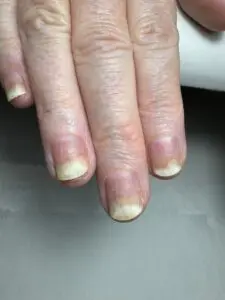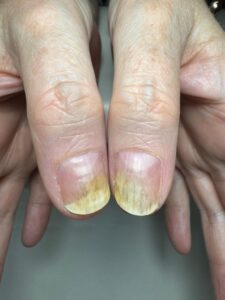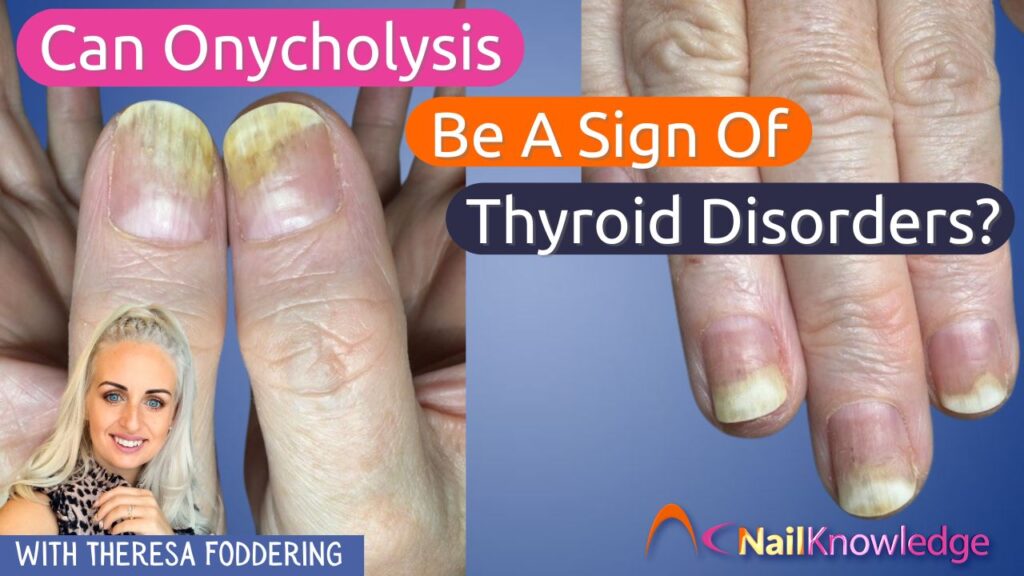Recently, I’ve been assisting a fellow professional with a particularly challenging case of long-standing onycholysis (nail separation). This client also has a history of systemic disorders, latex, and other dermatological allergies, and despite trying various treatments, applications, and products, we cannot pinpoint the root cause. Through persistent research, one issue has stood out, a serious thyroid disorder. This discovery pushed me down the rabbit hole of medical journals and publications to understand the connection between thyroid health and its effects on nails and skin. It’s a habit I’m known for, researching relentlessly to uncover answers, and this time was no different.
What I found was fascinating and deeply relevant to nail professionals. The thyroid gland, often overlooked in our industry, can profoundly affect the nails and skin, presenting signs that may otherwise be dismissed or misdiagnosed. Let’s highlight what I’ve uncovered.


The Role of the Thyroid Gland
The thyroid gland is a butterfly-shaped organ located in the neck. Despite its size, it’s a powerhouse of activity, producing hormones that regulate nearly every aspect of metabolism. These hormones influence everything from cell growth and repair to energy production, heart rate, digestion, brain function, and more. In short, the thyroid is a ‘master regulator’, ensuring the body operates in balance.
When the thyroid malfunctions, these hormonal imbalances can cause widespread issues, including visible changes in nails and skin. These changes often serve as early warning signs of deeper systemic problems.
Hyperthyroidism vs Hypothyroidism: The Key Differences
Hyperthyroidism (Overactive Thyroid)
- The thyroid produces too much hormone, speeding up metabolism.
- Symptoms: Rapid weight loss, anxiety, restlessness, heat intolerance, muscle weakness, and thinning skin or hair.
- Impact on Nails: Onycholysis (Plummer’s nails) is common, this is where the nail separates from the nail bed, often seen on the middle or ring fingers. Nails may also appear thin and fragile. (Plummer’s Nails only refers to nail separation when caused by thyroid disorders)
- Impact on Skin: Sweaty, warm, and thin skin, prone to tearing.
Hypothyroidism (Underactive Thyroid)
- The thyroid produces too little hormone, slowing down metabolism.
- Symptoms: Fatigue, weight gain, cold intolerance, depression, dry skin, and puffiness.
- Impact on Nails: Brittle, slow-growing nails; vertical ridges; thickened nail plates; and spoon-shaped nails (Koilonychia) in severe cases.
- Impact on Skin: Dry, flaky, and rough skin; a yellowish tinge and delayed wound healing.
Thyroid Disorders and Nail Health
The effects of thyroid dysfunction on nails are often overlooked or misattributed. Here are some common nail changes to watch for:
- Onycholysis (Nail Separation):
Often linked to hyperthyroidism, this condition involves the detachment of the nail plate from the nail bed. While onycholysis can also result from trauma, allergies, or infections, thyroid dysfunction is a critical consideration that is frequently missed. - Slow Nail Growth and Brittleness:
Hypothyroidism slows the metabolic processes, leading to slow nail growth and brittle, peeling nails. - Thickened Nails:
In some cases of hypothyroidism, keratin build-up can cause nails to thicken, creating a rough or irregular texture. - Vertical Ridges:
Prominent ridging on the nail plate may be due to weakened keratin production associated with hypothyroidism. - Dryness and Cracking:
Thyroid disorders often cause a lack of condition in the skin and nails, leading to cracks, splits, and increased susceptibility to secondary infections.
The Bigger Picture: Dryness, Thickening, Ridges, and Onycholysis
One of the most common correlations I’ve observed over the years is the combination of nail dryness, thickening, and ridges culminating in onycholysis. Too often, onycholysis is immediately attributed to an allergic reaction, leading to incorrect advice and missed referrals. While allergies can cause nail separation, it is just one of many potential causes. By becoming overly focused on allergy as the sole explanation, we risk overlooking serious underlying health conditions like thyroid dysfunction.
For example, a client presenting with ridged, brittle nails and onycholysis may be dealing with hypothyroidism rather than an irritant. These signs demand a more holistic assessment and, where necessary, a referral to a healthcare professional.
What Can Nail Professionals Do?
As nail professionals, our role isn’t to diagnose medical conditions, but we are often the first to notice changes in our clients’ nails and skin. Here’s how we can support them:
- Recognise the Signs:
Educate yourself about the visible effects of thyroid dysfunction on nails and skin. Pay attention to patterns like slow growth, thickened nails, or persistent onycholysis.
- Avoid Jumping to Conclusions:
Don’t immediately attribute nail separation to allergies or external factors. Consider the bigger picture, including systemic health issues.
- Tailor Your Treatments:
Provide gentle, conditioning treatments to combat dryness and brittleness. Avoid aggressive, or even unnecessary, filing or buffing, which could swiftly worsen the problem.
- Encourage Professional Consultation:
If you suspect an underlying thyroid issue or any possible systemic disorder, suggest that your client consult their GP.
Always Look Beneath the Surface
Thyroid disorders are more common than many of us realise, particularly among women over 40 or those experiencing hormonal changes. Yet, the visible signs on nails and skin often go unnoticed or misattributed. As professionals, we have a unique opportunity to recognise these signs early and guide our clients toward the right advice.
The case I mentioned at the start of this blog is a perfect example. By diving deeper into the possible causes of the client’s onycholysis, we uncovered a possible answer to our journey enabling us to assist her better with every service, not to mention highlighting the Nail Professionals’ expertise and professionalism against her competition but to existing and future clients. This experience reinforced the importance of staying curious, informed, and open-minded when addressing nail and skin abnormalities.
So next time you see a client with persistent onycholysis, brittle nails, or dry, flaky skin, remember, it could be more than meets the eye. And in those moments, your expertise and guidance could make all the difference.
Learn more about Onycholysis and what causes it?


